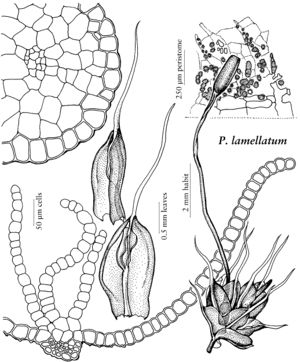Pterygoneurum lamellatum
Laubm.-Fl. Oesterr.-Ung., 97. 1882,.
Leaves with distal lamina sometimes weakly papillose abaxially; awn smooth; lamellae (0–) 8–14 cells in height, irregularly lobed, often bearing filaments. Capsule stegocarpous, exerted, short to long-cylindric, annulus present, operculum cells in twisted rows; peristome present, fragile and often adherent to the operculum. Calyptra cucullate.
Phenology: Capsules mature late winter, spring.
Habitat: Soil, rock faces
Elevation: moderate elevations (500-1400 m)
Distribution

B.C., Nunavut, Alaska, Ariz., Calif., Nev., Utah, Europe, Asia
Discussion
The operculum of Pterygoneurum lamellatum is commonly long-conic when dry, while that of P. ovatum is generally linear. The peristome may be trellislike (illustrated by S. Flowers 1973) or a rudimentary arrangement of small plates over a membrane (R. H. Zander 1993), or even absent. Also keying to P. lamellatum is the British Columbian specimen reported by T. T. McIntosh (1989) as Tortula wilsonii (Hooker) R. H. Zander. This proved to be a species, possibly new, of Pterygoneurum distinguished by broadly recurved leaf margins and multiple papillae on both sides of the leaf above mid leaf. The adaxial costal lamellae are distinct but occasionally absent in some plants, which then phenocopy Tortula or Hilpertia. This specimen in turn proved to be similar to a Pterygoneurum discussed but not formally described by B. M. Murray (1992) for Alaska; a name will be provided in a future publication.
Selected References
None.
Lower Taxa
"um" is not declared as a valid unit of measurement for this property.
